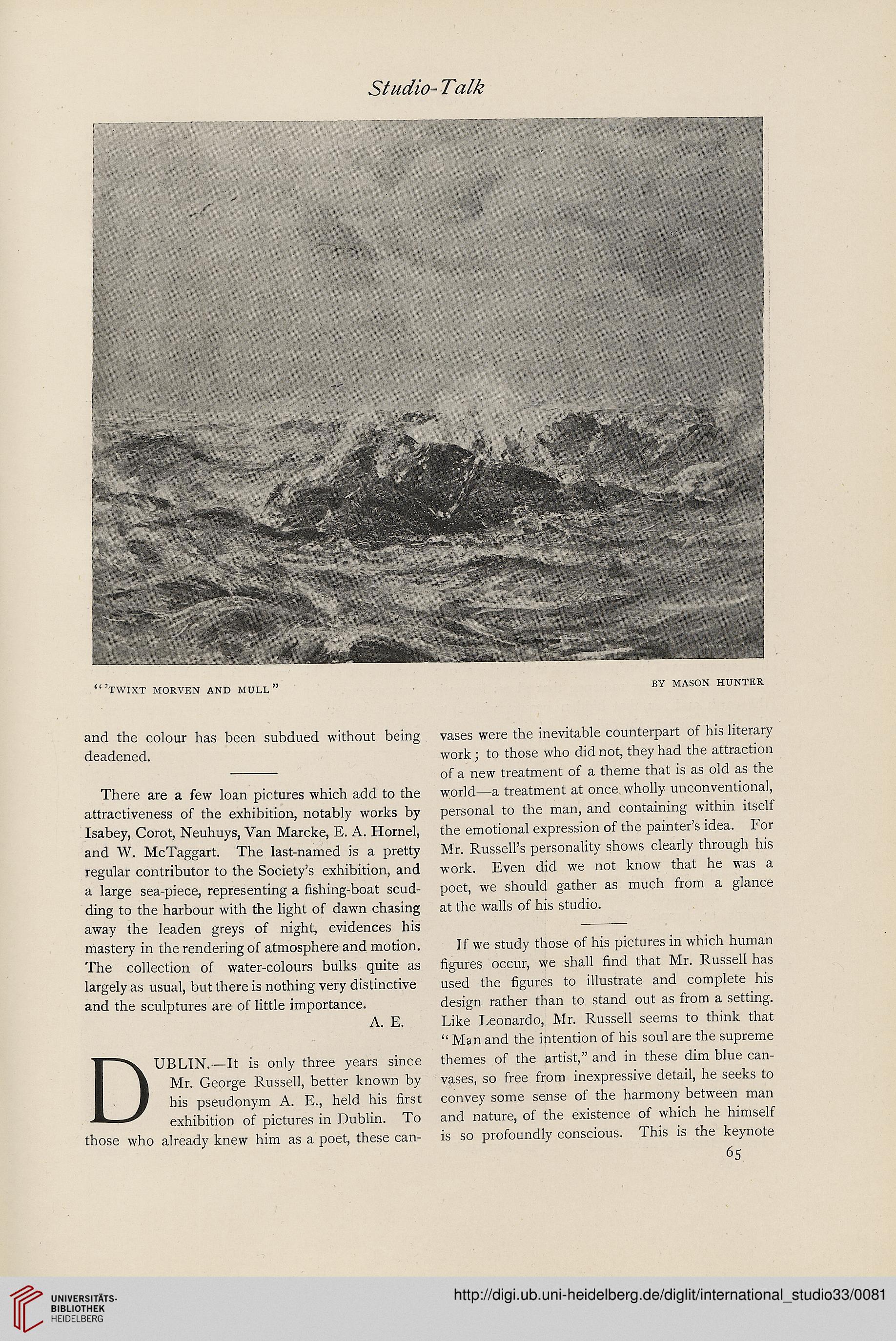Studio- Talk
and the colour has been subdued without being
deadened.
There are a few loan pictures which add to the
attractiveness of the exhibition, notably works by
Isabey, Corot, Neuhuys, Van Marcke, E. A. Hornel,
and W. McTaggart. The last-named is a pretty
regular contributor to the Society’s exhibition, and
a large sea-piece, representing a fishing-boat scud-
ding to the harbour with the light of dawn chasing
away the leaden greys of night, evidences his
mastery in the rendering of atmosphere and motion.
The collection of water-colours bulks quite as
largely as usual, but there is nothing very distinctive
and the sculptures are of little importance.
A. E.
DUBLIN.—It is only three years since
Mr. George Russell, better known by
his pseudonym A. E., held his first
exhibition of pictures in Dublin. To
those who already knew him as a poet, these can-
vases were the inevitable counterpart of his literary
work ; to those who did not, they had the attraction
of a new treatment of a theme that is as old as the
world—a treatment at once wholly unconventional,
personal to the man, and containing within itself
the emotional expression of the painter’s idea. For
Mr. Russell’s personality shows clearly through his
work. Even did we not know that he was a
poet, we should gather as much from a glance
at the w7alls of his studio.
1 f we study those of his pictures in which human
figures occur, we shall find that Mr. Russell has
used the figures to illustrate and complete his
design rather than to stand out as from a setting.
Like Leonardo, Mr. Russell seems to think that
“ Man and the intention of his soul are the supreme
themes of the artist,” and in these dim blue can-
vases, so free from inexpressive detail, he seeks to
convey some sense of the harmony between man
and nature, of the existence of which he himself
is so profoundly conscious. This is the keynote
65
and the colour has been subdued without being
deadened.
There are a few loan pictures which add to the
attractiveness of the exhibition, notably works by
Isabey, Corot, Neuhuys, Van Marcke, E. A. Hornel,
and W. McTaggart. The last-named is a pretty
regular contributor to the Society’s exhibition, and
a large sea-piece, representing a fishing-boat scud-
ding to the harbour with the light of dawn chasing
away the leaden greys of night, evidences his
mastery in the rendering of atmosphere and motion.
The collection of water-colours bulks quite as
largely as usual, but there is nothing very distinctive
and the sculptures are of little importance.
A. E.
DUBLIN.—It is only three years since
Mr. George Russell, better known by
his pseudonym A. E., held his first
exhibition of pictures in Dublin. To
those who already knew him as a poet, these can-
vases were the inevitable counterpart of his literary
work ; to those who did not, they had the attraction
of a new treatment of a theme that is as old as the
world—a treatment at once wholly unconventional,
personal to the man, and containing within itself
the emotional expression of the painter’s idea. For
Mr. Russell’s personality shows clearly through his
work. Even did we not know that he was a
poet, we should gather as much from a glance
at the w7alls of his studio.
1 f we study those of his pictures in which human
figures occur, we shall find that Mr. Russell has
used the figures to illustrate and complete his
design rather than to stand out as from a setting.
Like Leonardo, Mr. Russell seems to think that
“ Man and the intention of his soul are the supreme
themes of the artist,” and in these dim blue can-
vases, so free from inexpressive detail, he seeks to
convey some sense of the harmony between man
and nature, of the existence of which he himself
is so profoundly conscious. This is the keynote
65




